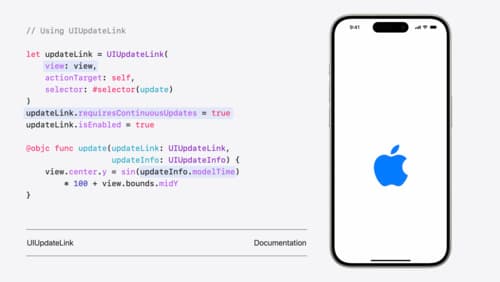В чём отличие SwiftUI от UIKit
Asked on 2024-08-06
1 search
SwiftUI and UIKit are both frameworks for building user interfaces on Apple platforms, but they have some key differences:
-
Declarative vs. Imperative:
- SwiftUI: Uses a declarative syntax, meaning you describe what the UI should look like and how it should behave. SwiftUI takes care of the rendering and updating of the UI. This approach allows for more concise and readable code.
- UIKit: Uses an imperative approach, where you explicitly define the steps to create and update the UI. This often results in more verbose code but provides fine-grained control over the UI elements.
-
Interoperability:
- SwiftUI: Designed to work seamlessly with UIKit and AppKit. You can embed UIKit views in SwiftUI using
UIViewRepresentableand embed SwiftUI views in UIKit usingUIHostingController. This interoperability allows developers to incrementally adopt SwiftUI in existing UIKit-based projects. - UIKit: While it can interoperate with SwiftUI, it is primarily used in an imperative manner and does not natively support the declarative syntax of SwiftUI.
- SwiftUI: Designed to work seamlessly with UIKit and AppKit. You can embed UIKit views in SwiftUI using
-
Animations and Gestures:
- SwiftUI: Provides a powerful and easy-to-use API for animations and gestures. You can use SwiftUI's animation types to animate UIKit views and create fluid gesture-driven animations.
- UIKit: Also supports animations and gestures but requires more boilerplate code compared to SwiftUI. UIKit's gesture recognizers can now be used in SwiftUI views, enhancing interoperability.
-
Platform Support:
- SwiftUI: Designed to work across all Apple platforms (iOS, macOS, watchOS, tvOS, visionOS). It allows for code sharing and adaptive views that provide a consistent look and feel across different devices.
- UIKit: Primarily used for iOS and tvOS. For macOS, AppKit is the equivalent framework.
-
Customization and Control:
- SwiftUI: While it provides a high level of abstraction, it also offers low-level APIs for custom controls, layouts, and even metal shaders. This allows for creating unique and highly customized user experiences.
- UIKit: Offers extensive customization options and has a rich set of capabilities built over many years. It provides detailed control over every aspect of the UI.
For more detailed information, you can refer to the following sessions from WWDC 2024:
- Platforms State of the Union (35:12)
- SwiftUI essentials (20:31)
- What’s new in UIKit (03:35)
These sessions provide insights into the latest updates and features of both SwiftUI and UIKit, as well as their interoperability.

SwiftUI essentials
Join us on a tour of SwiftUI, Apple’s declarative user interface framework. Learn essential concepts for building apps in SwiftUI, like views, state variables, and layout. Discover the breadth of APIs for building fully featured experiences and crafting unique custom components. Whether you’re brand new to SwiftUI or an experienced developer, you’ll learn how to take advantage of what SwiftUI has to offer when building great apps.

Platforms State of the Union
Discover the newest advancements on Apple platforms.

What’s new in UIKit
Explore everything new in UIKit, including tab and document launch experiences, transitions, and text and input changes. We’ll also discuss better-than-ever interoperability between UIKit and SwiftUI animations and gestures, as well as general improvements throughout UIKit.
